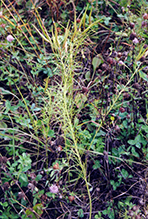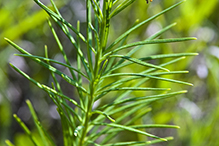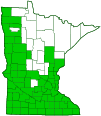whorled milkweed
(Asclepias verticillata)
Conservation • Wetland • Description • Habitat • Ecology • Use • Distribution • Taxonomy
Description |
Whorled milkweed is a 8″ to 20″ tall, erect, perennial herb that rises from a rhizome and fleshy roots. It often forms colonies. The leaves and stems contain a milky juice. The stems are erect, unbranched below the inflorescence, and ridged. They have short, soft hairs in lines on the ridges. The leaves are numerous in whorls of 3 to 6. They are linear and are attached to the stem without a leaf stalk. They may be erect, semi-erect, or spreading. The blades are ¾″ to 3″ long, less than ⅛″ wide, with pointed tips. The margins are untoothed and rolled backward toward the underside. The inflorescence is several loose, small, umbrella-shaped clusters (umbels) rising from the upper leaf axils. The clusters are 2″ to 3″ in diameter and are on a ½″ to 1½″ long stalk. They typically have 10 to 20 flowers. The structure of the typical milkweed flower is unique and instantly recognizable. There are 5 petals bent backward at the base and hanging downward. Subtending the petals are 5 much shorter, light green, lance-shaped sepals. There are 5 stamens. Formed from the filament of each stamen is a petal-like appendage. The appendage consists of a tubular hood surrounding an awl-shaped horn in the center of the hood. The stamens and the stigma are fused together into a crown-like structure (gynostegium). Each stigma has a long slit designed to catch the legs of a pollinating insect. A small, dark, sticky gland above this slit is attached to pollen sacs from adjacent anthers. These glands are designed to break off as an insect pulls its leg free of the slit, and remain attached to the insects leg. The flowers are pollinated by larger insects strong enough to lift off with the pollen sacs attached. Smaller insects are caught in a death trap or leave behind their detached legs. The flowers of this plant are shaped like the typical milkweed flower. They are about ¼″ tall, ⅓″ wide, and are attached on ¼″ to ½″ long thread-like stalks. The petals are greenish white and are tinged with purple near the tip. They bend backward at the base, hang downward, then curl upward near the tip. They are separated from the hoods by a distinct column. The hoods are white. The horns are white and are longer than the hoods. They project from the hoods and bend inwards. There is little or no fragrance. The fruit is a narrow, spindle-shaped pod. It is 3″ to 4″ long and ¼″ to ⅓″ wide. It is held erect or ascending on an erect stalk. It opens on one side exposing the seeds to spreading by the wind. The seeds have a tuft of hairs at the tip that are whitish and about 1⅛″ long. |
Height |
8″ to 20″ |
Flower Color |
White horns, greenish-white petals tinged with purple |
Similar Species |
Green milkweed (Asclepias viridiflora) leaves are much wider, lance-shaped to oblong, mostly opposite, with wavy margins. It usually has just 1 to 3 flower clusters. The clusters have 20 to 80 flowers. The flowers are not tinged with purple. The petals are attached directly to the hoods, not separated by a column. Prairie milkweed (Asclepias hirtella) is a much taller plant, 16″ to 40″ tall at maturity. The leaves are longer and narrower, lance-shaped to linear, and alternate. It has 2 to 10 flower clusters. The clusters have 30 to 100 flowers. |
Habitat |
Dry. Prairies, fields, open upland woods, roadsides. |
Ecology |
Flowering |
July to September |
Faunal Associations |
Milkweeds are the only plants that Monarchs lay their eggs on. The eggs are laid on the underside of healthy young leaves. |
Toxicity |
This and other milkweeds contain cardiac glycosides and may be poisonous to both humans and livestock. |
Pests and Diseases |
|
Use |
|
Distribution |
||
|
Sources |
|
| 2/4/2025 | ||
Nativity |
||
Native |
||
Occurrence |
||
|
||
Taxonomy |
|
Kingdom |
|
Division |
Tracheophyta (Vascular Plants) |
Subdivision |
Spermatophytina (Seed Plants) |
Class |
|
Order |
Gentianales (Gentians, Dogbanes, Madders, and Allies) |
Family |
Apocynaceae (dogbane) |
Subfamily |
Asclepiadoideae (milkweeds) |
Tribe |
Asclepiadeae |
Subtribe |
Asclepiadinae |
Genus |
|
Subordinate Taxa |
|
|
|
Synonyms |
|
Asclepias galioides Asclepias linifolia Asclepias parviflora |
|
Common Names |
|
eastern whorled milkweed horsetail milkweed whorled milkweed |
|
Glossary
Axil
The upper angle where the leaf stalk meets the stem.
Gynostegium
A crown-like structure of plants of the genus Asclepias formed by the fusion of the anthers with the stigmas.
Linear
Long, straight, and narrow, with more or less parallel sides, like a blade of grass.
Rhizome
A horizontal, usually underground stem. It serves as a reproductive structure, producing roots below and shoots above at the nodes.
Umbel
A flat-topped or convex, umbrella-shaped cluster of flowers or buds arising from more or less a single point.
Visitor Photos |
||
Share your photo of this plant. |
||
This button not working for you? |
||
Nancy Falkum |
||
 |
 |
|
MinnesotaSeasons.com Photos |
||
 |

|
|
Plant |
||
|
||
|
||
Plant |
||
 |
 |
|
Plant |
Plant |
|
 |
 |
|
Inflorescence |
Inflorescence |
|
 |
 |
|
Flowers |
||
|
||
|
||
Inflorescence |
|
|
 |
 |
|
Leaves |
Leaves |
|
 |
 |
|
Leaves |
Infructescence |
|
 |
||
Infructescence |
|

Slideshows |
Asclepias verticillata WHORLED MILKWEED |

|
A. verticillata |

|
About
Whorled Milkweed |

Visitor Videos |
||
Share your video of this plant. |
||
This button not working for you? |
||
|
Other Videos |
||
Honeybee forages on whorled milkweed |
About
Uploaded on Jul 10, 2011 A Honeybee forages on whorled milkweed, Asclepias verticillata, on July 8, 2011 at Killdeer Plains Wildlife Area in Wyandot County, Ohio, USA. |

Visitor Sightings |
||
Report a sighting of this plant. |
||
This button not working for you? |
||
Nancy Falkum |
Location: Oronoco Prairie SNA |
 |
| Nancy Falkum 7/22/2021 |
Location: Kellogg Weaver Dunes SNA, Weaver Dunes Unit |
 |
MinnesotaSeasons.com Sightings |
||
Felton Prairie SNA, Bicentennial Unit Kellogg Weaver Dunes SNA, Kellogg Weaver Unit Margherita Preserve-Audubon Prairie Mound Spring Prairie SNA, North Unit Mound Spring Prairie SNA, South Unit Northern Tallgrass Prairie NWR, Hoffman Unit Northern Tallgrass Prairie NWR, Rengstorf Unit |

|
Created: Last Updated: © MinnesotaSeasons.com. All rights reserved. |
